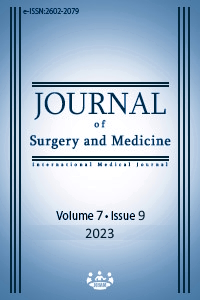Primary closure method after asymmetrical excision of a pilonidal sinus treatment: A retrospective cohort study
Primary closure method of a pilonidal sinus treatment
Keywords:
pilonidal sinus, primary closure, recurrenceAbstract
Background/Aim: There is no gold standard method in pilonidal sinus surgery, because each technique has a recurrence rate. This study aims to evaluate the outcomes of pilonidal sinus surgeries performed by a single surgeon using excision and primary closure technique in a state hospital.
Methods: The study included 159 pilonidal sinus patients operated on by a single surgeon in the General Surgery Department between September 2014 and May 2022. The patients were investigated retrospectively, and age, gender, surgical technique, type of anesthesia administered, time needed to return to normal life, history of previous abscess drainage, long-term complaints in the incision area, number of intergluteal sinuses, postoperative complications and recurrence rates were recorded. Missing information was completed with polyclinic medical records and phone calls. Patients with incomplete data were excluded from the study. An excision and primary closure method was performed on all patients included in the study.
Results: Sixty-seven (42.1%) of the patients were male and 92 (57.9%) were female. The mean age was 27.8 (8.97) years. Twenty-one (13.2%) patients were operated on under local anesthesia, whereas 138 (86.8%) received spinal anesthesia. The mean operative time was 28.87 (8.01) minutes (range: 14-47 minutes). The mean length of hospital stay was determined to be one day (range: 6-24 hours). Surgical-site infections developed in 4 (2.5%) patients and wound dehiscence developed in 14 (8.8%) patients during the postoperative period. Patients developing these conditions were followed up with dressing and antibiotic treatment. The mean postoperative follow-up period was 67 months (range: 1-105 months). Recurrence was detected in six patients during the follow-up period, representing a recurrence rate of 3.8%.
Conclusion: Primary closure after asymmetrical excision of the pilonidal sinus is an easily performed technique with minimal postoperative pain and early wound healing. Additionally, this method has early return-to-work rates and low recurrence rates. We think that this method would be more applicable in pilonidal sinus surgery due to these advantages.
Downloads
References
Turhan VB, Ünsal A, Öztürk B, Öztürk D, Buluş H. Comparison of excision and primary closure vs. crystallized phenol treatment in pilonidal sinus disease: A comparative retrospective study. J Surg Med. 2021;5(10):1007-10. DOI: https://doi.org/10.28982/josam.1001636
Urhan MK, Kücükel F, Topgul K, Ozer I, Sari S. Rhomboid excision and Limberg flap for managing pilonidal sinus: results of 102 cases. Dis Colon Rectum. 2002;45:656-9. DOI: https://doi.org/10.1007/s10350-004-6263-4
Emir S, Kanat B.H, Yazar F, Gürdal S. Sakrokoksigeal Pilonidal Sinüsün Cerrahi Tedavisinde Karydakis Flep Ameliyatının Kısa ve Uzun Dönem Sonuçları. Int J Basic Clin Med. 2013;1(1):15-8.
Kaya B, Uçtum Y, Şimşek A, Kutanış R. Pilonidal Sinüs Tedavisinde Primer Kapama. Basit ve Etkili Bir Yöntem. Kolon Rektum Hast Derg. 2010; 20(2):59-65.
Dalenback J, Magnussom O, Wedel N, Rimback G. Prospective follow-up after ambulatory plain midline excision of pilonidal sinus and primary suture under local anesthesia-efficient, sufficient, and persistent. Colorectal Dis. 2004;6:488-93. DOI: https://doi.org/10.1111/j.1463-1318.2004.00693.x
Igors I, Andreas O. The Management of Pilonidal Sinus. Dtsch Arztebl Int. 2019;116:12–21.
Toydemir T, Peşluk O, Ermeç ED, Turhan AN. Sakrokosigeal Pilonidal Sinüs Hastalığının Cerrahi Tedavisinde Karydakis Flap ile Primer Kapama Prosedürlerinin Klinik Sonuçlarının Karşılaştırılması. Bakırköy Tıp Dergisi. 2012;8(2):78-81. DOI: https://doi.org/10.5350/BTDMJB201208206
Al-Jaberi TM. Excision and simple primary closure of chronic pilonidal sinus. Eur J Surg. 2001;167:133-5. DOI: https://doi.org/10.1080/110241501750070600
Al-Hassan HK, Francis IM, Neglén P. Primary closure or secondary granulation after excision of pilonidal sinus? Acta Chir Scand. 1990;156:695-9.
Cihan A, Menteş BB, Tatlıcıoğlu E, Ozmen S, Leventoglu S, Ucan B.H. Modified Limberg flap reconstruction compares favorably with primary repair for pilonidal sinus surgery. ANZ J Surg. 2004;74:238-42. DOI: https://doi.org/10.1111/j.1445-2197.2004.02951.x
Keskin Aİ, Polat Y, Duran E, Çetinkünar S, Zorlu M. Pilonidal sinüs olgularında dört farklı cerrahi tekniğin karşılaştırılması. Dicle Tıp Dergisi. 2014;41(3):558-63. DOI: https://doi.org/10.5798/diclemedj.0921.2014.03.0474
Muzi MG, Milito G, Nigro C, Cadeddu F, Farinon AM. A modification of primary closure for the treatment of pilonidal disease in a day-care setting. Colorectal Dis. 2009;11.84-8. DOI: https://doi.org/10.1111/j.1463-1318.2008.01534.x
Kapan M, Kapan S, Pekmezci S, Durgun V. Sacrococcygeal pilonidal sinus disease with Limberg flap repair. Tech Coloproctol. 2002;6:27-32. DOI: https://doi.org/10.1007/s101510200005
Eryılmaz R, Sahin M, Alimoglu O, Dasıran F. Surgical treatment of sacrococcygeal pilonidal sinus with the Limberg transposition flap. Surgery. 2003;134:745-9. DOI: https://doi.org/10.1016/S0039-6060(03)00163-6
Downloads
- 504 869
Published
Issue
Section
How to Cite
License
Copyright (c) 2023 Tuba Atak
This work is licensed under a Creative Commons Attribution-NonCommercial-NoDerivatives 4.0 International License.
















